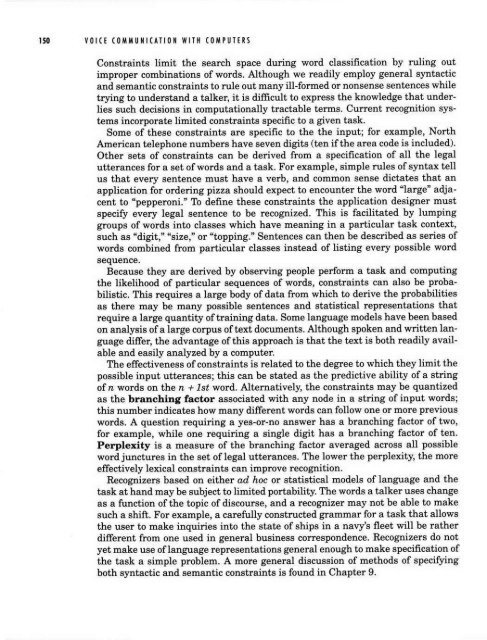MAS.632 Conversational Computer Systems - MIT OpenCourseWare
MAS.632 Conversational Computer Systems - MIT OpenCourseWare
MAS.632 Conversational Computer Systems - MIT OpenCourseWare
You also want an ePaper? Increase the reach of your titles
YUMPU automatically turns print PDFs into web optimized ePapers that Google loves.
150 VOICE COMMUNICATION WITH COMPUTERS<br />
Constraints limit the search space during word classification by ruling out<br />
improper combinations of words. Although we readily employ general syntactic<br />
and semantic constraints to rule out many ill-formed or nonsense sentences while<br />
trying to understand a talker, it is difficult to express the knowledge that underlies<br />
such decisions in computationally tractable terms. Current recognition systems<br />
incorporate limited constraints specific to a given task.<br />
Some of these constraints are specific to the the input; for example, North<br />
American telephone numbers have seven digits (ten if the area code is included).<br />
Other sets of constraints can be derived from a specification of all the legal<br />
utterances for a set of words and a task. For example, simple rules of syntax tell<br />
us that every sentence must have a verb, and common sense dictates that an<br />
application for ordering pizza should expect to encounter the word "large" adjacent<br />
to "pepperoni." To define these constraints the application designer must<br />
specify every legal sentence to be recognized. This is facilitated by lumping<br />
groups of words into classes which have meaning in a particular task context,<br />
such as "digit," "size," or "topping." Sentences can then be described as series of<br />
words combined from particular classes instead of listing every possible word<br />
sequence.<br />
Because they are derived by observing people perform a task and computing<br />
the likelihood of particular sequences of words, constraints can also be probabilistic.<br />
This requires a large body of data from which to derive the probabilities<br />
as there may be many possible sentences and statistical representations that<br />
require a large quantity of training data. Some language models have been based<br />
on analysis of a large corpus of text documents. Although spoken and written language<br />
differ, the advantage of this approach is that the text is both readily available<br />
and easily analyzed by a computer.<br />
The effectiveness of constraints is related to the degree to which they limit the<br />
possible input utterances; this can be stated as the predictive ability of a string<br />
of n words on the n + 1st word. Alternatively, the constraints may be quantized<br />
as the branching factor associated with any node in a string of input words;<br />
this number indicates how many different words can follow one or more previous<br />
words. A question requiring a yes-or-no answer has a branching factor of two,<br />
for example, while one requiring a single digit has a branching factor of ten.<br />
Perplexity is a measure of the branching factor averaged across all possible<br />
word junctures in the set of legal utterances. The lower the perplexity, the more<br />
effectively lexical constraints can improve recognition.<br />
Recognizers based on either ad hoc or statistical models of language and the<br />
task at hand may be subject to limited portability. The words a talker uses change<br />
as a function of the topic of discourse, and a recognizer may not be able to make<br />
such a shift. For example, a carefully constructed grammar for a task that allows<br />
the user to make inquiries into the state of ships in a navy's fleet will be rather<br />
different from one used in general business correspondence. Recognizers do not<br />
yet make use of language representations general enough to make specification of<br />
the task a simple problem. A more general discussion of methods of specifying<br />
both syntactic and semantic constraints is found in Chapter 9.

















